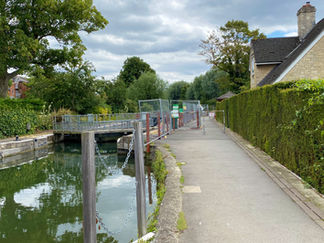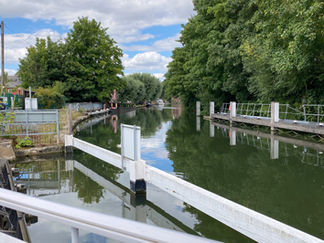The Route
This section begins on the south bank of the river, just south of the centre of Oxford. It continues northbound to the west of the city centre to Godstow. With noticeably more bends in the river, the path then continues through open countryside ending up at stunning Swinford Bridge.
This section is meant to be about 7 miles.
My Walk
For this walk I drove from home to Oxford and parked at the Redbridge Park & Ride site. I then walked the short distance to Donnington Bridge, a bridge we’d passed under on the Abingdon to Oxford walk. I joined the Thames Path here and retraced the steps to where the previous walk had ended.
The path entered Grandpont Nature Park. This is an area of grassland and wildflower meadows that is maintained by the council; you wouldn’t think you were in the middle of a city – it felt quite rural. A bridge that looked like a railway bridge came up next. However, it was now actually just a footbridge called the Gasworks Bridge for an obvious reason. Both the gasworks and the railway are long gone and today the bridge connects the St Ebbes district of Oxford with the nature reserve. The next bridge that came up was the Osney Rail Bridge that is still in service and carries the Oxford to Didcot line. Immediately after this was a wooden bridge crossing a Thames backwater called Bulstake Stream.
The path continued its rural feel for a while before crossing a metal bridge onto an island at Osney Lock, on which the lock keepers house stood. Another metal bridge connected the island back to the riverside. The path continued in a straight line alongside the river and with terraced houses on one side and industrial buildings on the other, this reminded me a little of Amsterdam and the canals running through the city.
Osney Bridge came up next. This carries the A420 from Botley into Oxford. The bridge was originally all stone but the central arches collapsed in 1885 and these were replaced by a single span metal bridge in 1888. There is only 7’ 6” of headroom under this main span and this seriously limits the size of craft that can pass under it, as one of my photos shows. I had to leave the path here, walk across the bridge to then rejoin the path on the other side of the river. As I walked up the steps from the path to the road, I happened to notice a heron standing in one of the small stone arches of the bridge. I was surprised to see that someone had written ‘@osneybird (insta,twitter)’ along with an arrow pointing to that arch, on a metal plate supporting the stairs up to the road. Subsequently I discovered that this heron is Oxford’s most famous and probably most photographed bird and does indeed have its own Instagram and Twitter accounts!
Anyway, having been amused by Osney Bird, I crossed the bridge and rejoined the towpath on the north bank of the river. To the right were the back gardens of terraced houses, whilst to the left were allotments. The Oxford Canal emerged from the right, necessitating walking over an attractive metal bridge and on to an island called Fiddler’s Island. The path continued along the left hand side of the island. I came across a squirrel minding his own business on top of a tree stump. Unusually, before running off up a tree, he posed long enough for me to take some photos of him! At the very end of the island, the Thames Path crossed an attractive red bridge, Medley Footbridge, that brought me back on to south bank of the river.
After crossing Medley Footbridge, the walk took on a completely different feel as the river widened and the landscape really opened up. On the opposite bank was Port Meadow, a huge 440 acre meadow of grazing land. Port Meadow is one of the most popular locations in Oxford for recreation activities such as walking, running, cycling and swimming in the river, or just relaxing of course. On my side of the river, after passing a pub, the path opened up to meadows and trees.
Godstow Lock came up next. This lock has an attractive stone lock keeper’s house and apparently has the honour of being the last upstream lock to have electrically powered lock gates. From here on, muscle power is needed! Immediately after the lock I came to the remains of Godstow Abbey, a medieval nunnery. The only building that remains now is the chapel and some boundary walls. Carrying on, the path came to Godstow Bridge, a Grade II listed bridge that carries a minor road between Wolvercote and Wytham. Both Godstow Abbey & Godstow Bridge were used as locations for the film Mama Mia! Here We Go Again. Almost immediately after the bridge came a pair of concrete bridges carrying the A34 over the river.
The river next snaked its way through peaceful countryside until the weir at King’s Lock came into view and then the lock itself. This is the first upstream lock that has manually operated gates. As ever, the lock and the gardens were immaculately kept. Just slightly upstream of the lock the river reaches its most northernmost point. Beyond the lock, the river continued to wend its way through the beautiful Oxfordshire countryside for a mile or so. Eventually Wytham Woods came into view to the left of the path. Wytham Woods is an ancient semi-natural woodland, which has been owned and maintained by the University of Oxford since 1942. Its 1000 acres are a designated Site of Special Scientific Interest and are one of the most researched pieces of woodland in the world, exceptionally rich in flora and fauna, with over 500 species of plants, a wealth of woodland habitats and 800 species of butterflies and moths (so their website tells me). Eynsham Lock came into view next. A few hundred yards after the lock, the path reached Swinford Bridge and this marked the end of the walk. Swinford Bridge is really interesting as well as being one of the most beautiful bridges across the Thames. It was built in 1769 out of local limestone. The bridge is governed by its own act of Parliament that allows its owner to collect tolls and also prevents anyone else building a bridge within 3 miles of it. The current owner of the bridge bought it at auction in 2009 for £1.08 million. The toll to cross is 5p for cars rising to 10p per axle for large trucks. You have to wonder if the owner makes any money from the tolls!
Having walked across the bridge and back to look at the views and take photos, I walked to the bus stop just south of the bridge. I didn’t have long to wait for the bus. Donning my face mask, I sat on the top deck and admired the stunning countryside back to Oxford. I then got the P&R bus back to my car and drove to the Cowley Premier Inn where I was going to stay for a couple of nights. A really enjoyable and interesting shorter walk.
Gallery


























